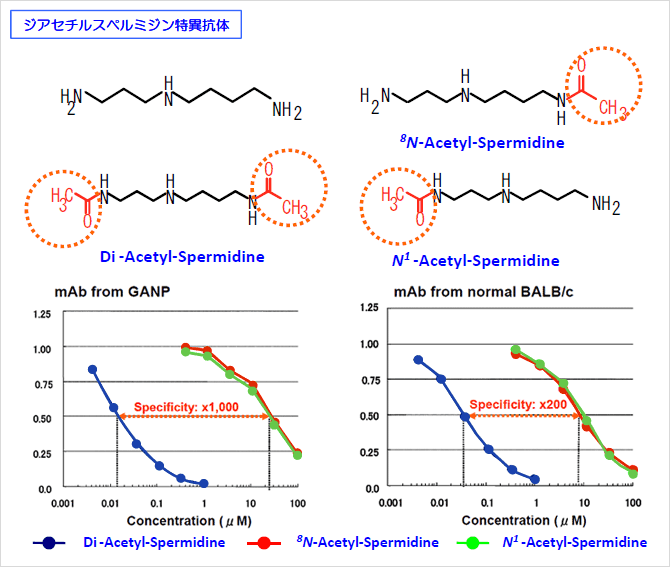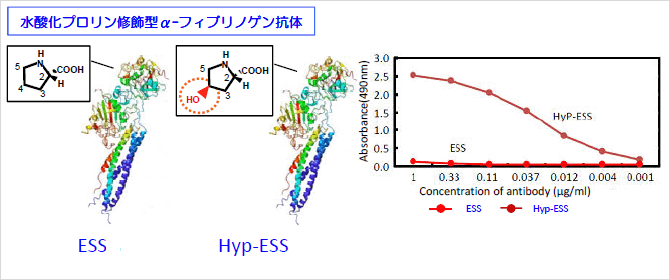Production of GANP® High-affinity Antibodies
We produce monoclonal antibodies using GANP® mice, which have a genetic background into which mutations can easily enter from the variable regions of antibodies. The monoclonal antibodies obtained using GANP® mice have greater diversity than those obtained using wild-type mice. As a result, high-affinity and high-specificity antibodies unobtainable with wild-type mice have been obtained.
Features
・High-affinity and high-specificity antibodies can be isolated
Principle
Discovered and named by Professor Nobuo Sakaguchi and others at Kumamoto University, germinal center-associated nuclear protein (GANP) is a new intranuclear factor whose expression increases in B cells centered in the embryo. It has been shown that GANP plays an important role in the reconstruction of antibody genes, and that antibodies with a high affinity for immunizing antigens can be produced with transgenic mice, which express high levels of GANP.

< Reference >
Nature Communications 4, Article number:1830 | doi:10.1038/ncomms2823 | Received 15 October 2012 | Accepted 28 March 2013 | Published 07 May 2013
GANP regulates recruitment of AID to immunoglobulin variable regions by modulating transcription and nucleosome occupancy
Shailendra Kumar Singh, Kazuhiko Maeda, Mohammed Mansour Abbas Eid, Sarah Ameen Almofty, Masaya Ono, Phuong Pham, Myron F. Goodman & Nobuo Sakaguchi
Blood. 2000 Apr 1;95(7):2321-8.
A novel nuclear phosphoprotein, GANP, is up-regulated in centrocytes of the germinal center and associated with MCM3, a protein essential for DNA replication.
Kuwahara K, Yoshida M, Kondo E, Sakata A, Watanabe Y, Abe E, Kouno Y, Tomiyasu S, Fujimura S, Tokuhisa T, Kimura H, Ezaki T, Sakaguchi N.
Proc Natl Acad Sci U S A. 2004 January 27; 101(4): 1010-1015.
Germinal center-associated nuclear protein contributes to affinity maturation of B cell antigen receptor in T cell-dependent responses
Kazuhiko Kuwahara, Satoru Fujimura, Yoshimasa Takahashi, Naomi Nakagata, Toshitada Takemori, Shinichi Aizawa, and Nobuo Sakaguchi
J Immunol. 2005 Apr 15;174(8):4485-94.
Generation of high-affinity antibody against T cell-dependent antigen in the Ganp gene-transgenic mouse.
Sakaguchi N, Kimura T, Matsushita S, Fujimura S, Shibata J, Araki M, Sakamoto T, Minoda C, Kuwahara K.
Biochem Biophys Res Commun. 2008 Jan 4;365(1):22-8.
Production and characterization of a monoclonal antibody against GPR40 (FFAR1; free fatty acid receptor 1).
Hirasawa A, Itsubo C, Sadakane K, Hara T, Shinagawa S, Koga H, Nose H, Koshimizu TA, Tsujimoto G.
J Biol Chem. 2009 Oct 16;284(42):29041-9.
Prolyl 4-hydroxylation of alpha-fibrinogen: a novel protein modification revealed by plasma proteomics.
Ono M, Matsubara J, Honda K, Sakuma T, Hashiguchi T, Nose H, Nakamori S, Okusaka T, Kosuge T, Sata N, Nagai H, Ioka T, Tanaka S, Tsuchida A, Aoki T, Shimahara M, Yasunami Y, Itoi T, Moriyasu F, Negishi A, Kuwabara H, Shoji A, Hirohashi S, Yamada T.
J Biol Chem. 2010 Jul 30;285(31):23945-53.
GANP-mediated recruitment of activation-induced cytidine deaminase to cell nuclei and to immunoglobulin variable region DNA.
Maeda K, Singh SK, Eda K, Kitabatake M, Pham P, Goodman MF, Sakaguchi N.
Practical Example 1: Comparing monoclonal antibody affinities for 4-hydroxy-3-nitrophenyl acetyl
In order to see the difference in affinity between the monoclonal antibodies obtained from a GANP® mouse and those obtained from a wild-type mouse (C57BL/6), we obtained monoclonal antibodies for 4-hydroxy-3-nitrophenyl acetyl. As a result, we were able to show that the monoclonal antibodies from the GANP® mouse had a higher affinity than those from the wild-type mouse.
| GANP mouse (C57BL/6 strain) | Wild-type mouse (C57BL/6 strain) | ||
|---|---|---|---|
| Clone | Association constant (KD) | Clone | Association constant (KD) |
| NP-G2-6 | 7.05×10-8 | NP-W2-7 | 1.51×10-7 |
| NP-G2-9 | 3.24×10-8 | NP-W1-116 | 1.00×10-8 |
| NP-G2-12 | 4.92×10-8 | NP-W-1B9 | 1.24×10-8 |
| NP-G2-14 | 2.51×10-8 | NP-W-2D8 | 2.74×10-8 |
| NP-G2-15 | 1.10×10-7 | ||
| NP-G2-16 | 4.12×10-8 | ||
| NP-G-2E4 | 1.57×10-9 | ||
Sakaguchi et al. 2005 Journal of Immunology
Practical Example 2: Comparison of affinities of HIV antibodies
We focused on gp120, which is known to be a glycoprotein on the membrane of the human immunodeficiency virus (HIV). We artificially manufactured part (24 amino acids) of gp120, made a KLH conjugate from it, made that into an immunizing antigen, and obtained monoclonal antibodies. As a result, from a GANP® mouse we were able to obtain monoclonal antibodies that had an extremely high affinity as compared with those from a C57BL/6 strain of BALB/c mouse.
| GANP mouse (C57BL/6 strain) | Wild-type mouse (C57BL/6 strain) | BALB/c mouse | |||
|---|---|---|---|---|---|
| Clone | Association constant (KD) | Clone | Association constant (KD) | Clone | Association constant (KD) |
| G1-22 | 1.77×10-6 | W1-2 | 9.81×10-8 | B1-10 | 5.68×10-9 |
| G1-68 | 4.81×10-7 | W1-7 | 3.11×10-9 | B2-24 | 1.64×10-7 |
| G1-124 | 1.01×10-6 | W1-8 | 7.58×10-8 | B2-27 | 4.97×10-6 |
| G1-165 | 1.14×10-7 | W1-10 | 1.83×10-8 | ||
| G1-181 | 1.09×10-8 | W1-21 | 9.70×10-8 | ||
| G1-231 | 2.07×10-6 | W1-43 | 8.25×10-9 | ||
| G2-10 | 9.90×10-11 | W1-45 | 5.89×10-9 | ||
| G2-25 | 1.51×10-10 | W1-63 | 5.67×10-9 | ||
| W1-84 | 2.81×10-5 | ||||
Sakaguchi et al. 2005 Journal of Immunology
Gp120 is a protein indispensable for infecting CD4 cells. Of the antibodies obtained from the GANP® mouse, two monoclonal antibodies had high association constants, and it became clear that, at low concentrations, their neutralizing activity is extremely vigorous.

Sakaguchi et al. 2005 Journal of Immunology
Practical Example 3: Antibody specificity regarding a low molecular compound
Our company produced anti-diacetylspermine antibodies.
Diacetlyspermine is a polyamine with a molecular weight of 200-300. In addition to the antigen (indicated by blue in the graphs) used to make these antibodies, two molecules (green and red) are known that are extremely similar in both molecular weight and structure. The anti-diacetylspermine antibodies obtained using a GANP® mouse were found to have approximately 5 times the specificity of those obtained using a BALB/c mouse.

We sell an ELISA kit that uses these antibodies. For details, click here
Practical Example 4: Antibodies for a new pancreatic cancer marker
Our company obtained antibodies for this marker
Hydroxyproline fibrinogen-α is a new pancreatic cancer marker discovered by the National Cancer Center. In joint research with the Center, our company was unable to obtain antibodies for this marker with an existing wild-type mouse; however, using GANP® mice that we possess, we were able to obtain antibodies with extremely high specificity.
 A Japanese patent for these antibodies was issued in June 2009 (Patent No. 4319700). We were able to obtain the patent quickly by using the Patent Office’s “Early Examination Request System”. Trans Genic was the first biology-related company to use this system.
A Japanese patent for these antibodies was issued in June 2009 (Patent No. 4319700). We were able to obtain the patent quickly by using the Patent Office’s “Early Examination Request System”. Trans Genic was the first biology-related company to use this system.
